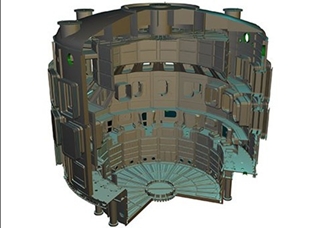
A contract has been awarded to Indian company, Larsen and Toubro Ltd. (L&T) for ITER Cryostat.
The Cryostat for the ITER experimental fusion reactor currently under construction in Southern France will be the world’s largest high-vacuum pressure chamber ever built. The contract for the manufacturing of the chamber was signed with L&T.
The steel structure will be made of stainless steel with thicknesses ranging from 50 mm to 250 mm.
The Cryostat for the ITER experimental fusion reactor currently under construction in Southern France will be the world’s largest high-vacuum pressure chamber ever built. The contract for the manufacturing of the chamber was signed with L&T.
The steel structure will be made of stainless steel with thicknesses ranging from 50 mm to 250 mm.
The Cryostat forms the vacuum-tight container surrounding the ITER vacuum vessel and the superconducting magnets essentially acting as a very large refrigerator.
The heavy-weight will bring more than 3,800 tons onto the scale, making it the largest vacuum vessel ever built out of stainless steel.
The Cryostat will have 23 penetrations allowing internal access for maintenance, as well as over 200 penetrations, some as large as four meters in size, providing access for the cooling systems, magnet feeders, auxiliary heating, diagnostics, and the removal of blanket and parts of the divertor. Large bellows are used between the Cryostat and the vacuum vessel to allow for thermal contraction and expansion in the structures.
India, being one of the seven Members of the ITER project, is in charge of procuring the Cryostat.
The heavy-weight will bring more than 3,800 tons onto the scale, making it the largest vacuum vessel ever built out of stainless steel.
The Cryostat will have 23 penetrations allowing internal access for maintenance, as well as over 200 penetrations, some as large as four meters in size, providing access for the cooling systems, magnet feeders, auxiliary heating, diagnostics, and the removal of blanket and parts of the divertor. Large bellows are used between the Cryostat and the vacuum vessel to allow for thermal contraction and expansion in the structures.
India, being one of the seven Members of the ITER project, is in charge of procuring the Cryostat.
The Cryostat will be manufactured by the Heavy Engineering division of L&T at its Hazira plant in Western India. It will be dispatched in 54 modules to the ITER site in Cadarache, as it cannot be transported in its entire size. Preassembly of the Cryostat modules will be done in a temporary workshop at the ITER site and then transported to the Tokamak pit where they will be welded together.

